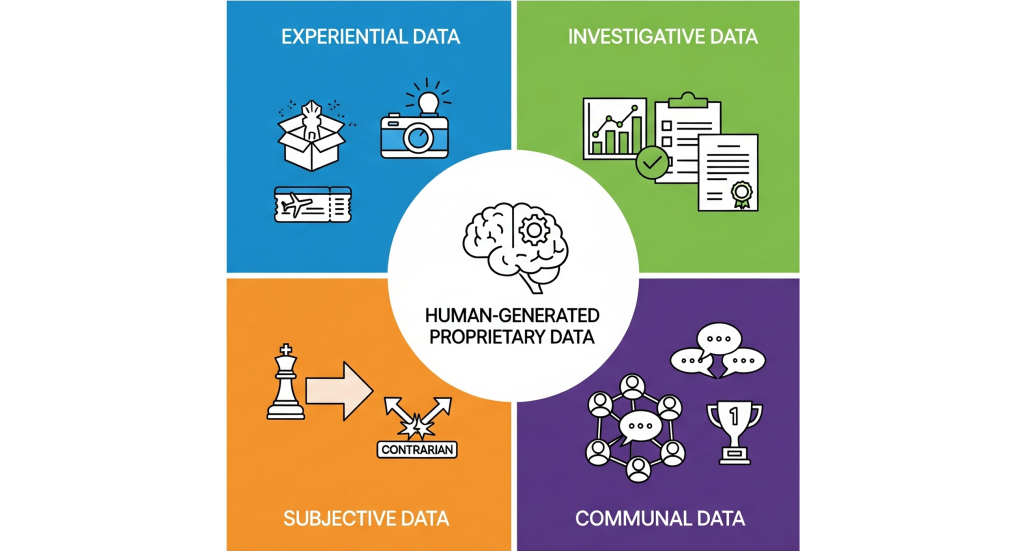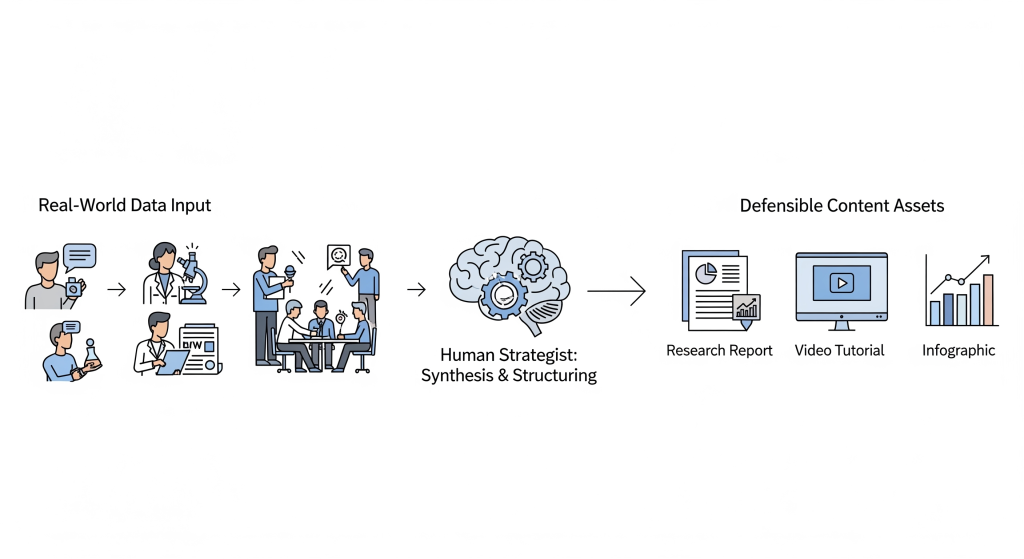The internet is full. As of today, September 5, 2025, the digital world is saturated with grammatically perfect, factually adequate, and utterly soulless content generated by artificial intelligence. The barrier to entry for content production has fallen to zero, and the result is a tidal wave of mediocrity. SEO, for a brief period, became a race to the bottom won by those with the cleverest prompts and the cheapest API calls.

That era is over.
Continuing to compete on volume is strategic malpractice. Search engines, drowning in this deluge of derivative information, are getting radically better at identifying and rewarding content that possesses one irreplicable quality: verifiable, first-hand human experience. Winning in this new landscape is not about a better prompt. It is about a fundamentally better process—a system that positions the human not as a writer or editor, but as the irreplaceable source of proprietary data.
This is the Human-in-the-Loop (HITL) SEO framework. It is the only defensible moat you have left.
The great content commoditization
For years, the promise of AI content was a utopian vision of efficiency. In reality, it has become a tragedy of the commons. When anyone can create a 2,000-word article on any topic in seconds, the value of such an article approaches zero. This is not a theoretical problem; it is the tactical reality on the ground.
Google’s helpful content system, once a subtle influence, now operates with ruthless efficiency. Its core function is to differentiate between content that synthesizes existing information and content that creates new information. AI is, by its very nature, a synthesizer. It is a brilliant summarizer of what is already known. It cannot, however, have a new experience. It cannot conduct a novel experiment. It cannot form a truly contrarian opinion based on decades of lived expertise.
The strategic imperative is clear: if your content creation process begins with an AI prompt, you have already lost. You are creating a commodity. The only way to build a long-term, defensible content asset is to create something that an AI could not possibly steal because it could not possibly have created it in the first place.
Redefining "Human-in-the-Loop" for content strategy
In the world of machine learning, “Human-in-the-Loop” is a technical term. It describes a process where humans are used to train, label, or validate the outputs of an AI model to improve its accuracy. This definition is insufficient for our purposes.
The Human-in-the-Loop SEO framework redefines this relationship. The human is not a downstream editor or a fact-checker. The human is the upstream source of unique data. The content creator’s primary job is no longer to write; it is to have experiences, conduct investigations, and form expert opinions. The written article, the video, or the infographic is merely the structured output of that human-generated data.
Think of it this way: the human is the API to the real world. An AI can access the internet’s API, but it cannot access the “physical world” API. It cannot unbox your product, it cannot interview your customer in person, and it cannot feel the frustration of a software bug. Your content strategy must be built entirely around exploiting this fundamental asymmetry.
The four pillars of the HITL framework
This framework provides a structure for creating inherently AI-proof content by focusing on four types of human-generated data.
Pillar 1: Experiential data (The 'E' in E-E-A-T)
This is the most straightforward pillar. It is content derived from physically doing something and documenting it with unimpeachable, first-hand evidence. This is the embodiment of the “Experience” factor in Google’s quality guidelines.
Brutally honest reviews: Do not write a “review” based on a company’s spec sheet. Buy the product. Use it for a month. Document the entire process with original, high-resolution photos and videos—the unboxing, the setup, the daily use, the moment it breaks. Show the receipts. This level of detail is impossible to fake and instantly authoritative.
Real-world project logs: Do not write “5 tips for migrating your database.” Instead, publish “A Step-by-Step Log of Our Migration from AWS DynamoDB to Google Cloud Spanner.” Include your actual code snippets, your internal Jira tickets, your final cost analysis, and a detailed post-mortem of the mistakes you made. This is not just content; it is a priceless case study.
Genuine event coverage: Go to the industry conference. Do not just summarize the keynote speeches—anyone can do that from the live stream. Talk to people in the hallways. Interview speakers after their talks. Synthesize the “unofficial” zeitgeist of the event. Your content becomes a source of unique insight that was only available to those physically present.
Pillar 2: Investigative data (Primary research)
If experiential data is about documenting reality, investigative data is about creating new knowledge. The goal is to become the primary source, the citation that everyone else—including AI models—must reference.
Industry surveys: Instead of guessing what your market thinks, ask them. Use tools like SurveyMonkey or Typeform to poll a statistically significant portion of your industry on a pressing issue. Publish the raw data, the analysis, and the key findings. You now own the definitive statistic on that topic for the year.
Unique dataset creation: Find multiple, disparate public datasets and combine them in a novel way to produce a new insight. For example, a marketing agency could cross-reference public FAA flight data with hotel occupancy rates and weather patterns to create the definitive guide on “the best day of the week to travel for business.”
Journalistic investigation: Use techniques like filing Freedom of Information Act (FOIA) requests to obtain government data that is not easily accessible. Interview a dozen industry veterans on a single topic and weave their exclusive quotes into a narrative. This is labor-intensive, but it creates a piece of content with an enormous competitive moat.

Pillar 3: Subjective data (True expertise)
This is perhaps the most difficult pillar to execute because it requires genuine, hard-won expertise. This is not about sharing a simple “opinion.” It is about providing a high-level strategic synthesis that can only come from decades of domain-specific experience. An AI can tell you what something is, but a true expert can tell you why it matters, what it will lead to, and what everyone else is missing.
Contrarian frameworks: Develop a unique, proprietary framework for thinking about a problem in your industry. A sales expert could create “The Asynchronous Closing Framework,” complete with diagrams and specific methodologies that challenge the conventional wisdom of high-pressure sales calls.
Non-obvious predictions: Go beyond generic trend-spotting. Make specific, falsifiable predictions about where your industry is headed in the next 5-10 years and provide a rigorous, first-principles argument for why you are right.
High-level synthesis: Take two or three seemingly unrelated trends and explain their combined impact. An expert in both AI and supply chain management could write the definitive piece on how generative AI will specifically impact port-of-entry logistics, an insight an AI trained on general knowledge could not produce.
Pillar 4: Communal data (Audience as a source)
This pillar leverages the fact that your community is a collection of humans with unique experiences. The content is derived from a process of curation and interaction with your audience.
Expert roundups: Identify the top 20 experts on a given topic and ask them all the same single, insightful question. Compile their answers into a single post. You are leveraging their collective expertise and social proof.
Content co-creation: Use your social media channels or newsletter to ask your audience for their single best tip on a specific problem. Curate the top 50 responses, attribute every single one, and structure it into the “ultimate crowd-sourced guide.”
Live AMAs (Ask Me Anything): Host a live, unscripted Q&A session with a genuine practitioner from your company. Record it, get it transcribed, and then edit the best questions and answers into a highly valuable, structured content asset that addresses the real-world concerns of your audience.
Implementing the HITL workflow
Adopting this framework requires a fundamental shift in how you structure your content team and allocate resources.
Hiring: Stop writing job descriptions for “content writers.” Start hiring for “analyst-communicators,” “practitioner-editors,” and “investigative marketers.” You need people who have done the work, not just people who can write about it. Hire the former engineer who can write, not the writer who has to interview an engineer.
Budgeting: This model is more expensive up front. Your content budget is no longer for freelance writers; it is for software subscriptions you can review, tickets to industry events, survey panel access, and data visualization tools. The ROI is not measured in cost-per-word but in the creation of evergreen, authority-building assets.
Technology’s new role: AI is not the enemy; it is a powerful tool in a secondary role. Use AI to transcribe your interviews, to summarize your survey data, or to polish the grammar of the report written by your human expert. The AI is a force multiplier for the human-generated data, but it is never the source.
The internet does not need another article. It is choking on content. What it needs is more truth, more proof, more verifiable reality. AI can generate the former in infinite quantities. Only humans, operating within a rigorous framework of experience, can provide the latter. Stop feeding the content machine and start documenting reality. It is the only moat you have left.

